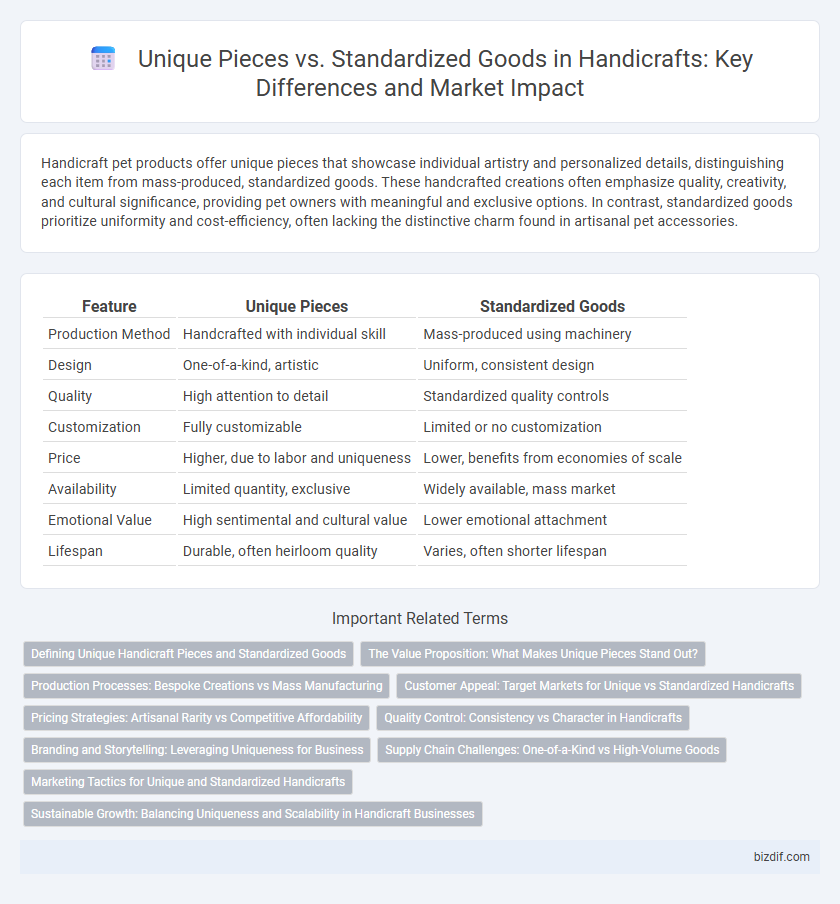Handicraft pet products offer unique pieces that showcase individual artistry and personalized details, distinguishing each item from mass-produced, standardized goods. These handcrafted creations often emphasize quality, creativity, and cultural significance, providing pet owners with meaningful and exclusive options. In contrast, standardized goods prioritize uniformity and cost-efficiency, often lacking the distinctive charm found in artisanal pet accessories.
Table of Comparison
| Feature | Unique Pieces | Standardized Goods |
|---|---|---|
| Production Method | Handcrafted with individual skill | Mass-produced using machinery |
| Design | One-of-a-kind, artistic | Uniform, consistent design |
| Quality | High attention to detail | Standardized quality controls |
| Customization | Fully customizable | Limited or no customization |
| Price | Higher, due to labor and uniqueness | Lower, benefits from economies of scale |
| Availability | Limited quantity, exclusive | Widely available, mass market |
| Emotional Value | High sentimental and cultural value | Lower emotional attachment |
| Lifespan | Durable, often heirloom quality | Varies, often shorter lifespan |
Defining Unique Handicraft Pieces and Standardized Goods
Unique handicraft pieces are individually crafted items that showcase distinct artistic expression, cultural heritage, and traditional techniques, often resulting in one-of-a-kind products with intrinsic value. Standardized goods, in contrast, are mass-produced items created through mechanized processes, ensuring uniformity and consistency across large quantities but lacking personalized craftsmanship. The distinction lies in the personalized creativity and cultural significance found in unique handicrafts versus the efficiency and predictability of standardized goods.
The Value Proposition: What Makes Unique Pieces Stand Out?
Unique handicraft pieces stand out due to their intrinsic originality and the artisanal skills involved in their creation, offering unmatched authenticity and cultural significance. Unlike standardized goods, these items provide personalized stories, limited availability, and superior craftsmanship, which enhance their emotional and aesthetic value. This exclusivity appeals to consumers seeking distinctive decor or gifts that reflect individual taste and heritage.
Production Processes: Bespoke Creations vs Mass Manufacturing
Bespoke creations in handicraft involve intricate, hands-on production processes that emphasize individuality and craftsmanship, resulting in unique pieces with distinct character and higher perceived value. Mass manufacturing uses automated techniques and standardized materials to produce large quantities of uniform goods efficiently, prioritizing speed and cost reduction over uniqueness. The contrast in production methods highlights the trade-off between personalized artistry and scalable output within the handicraft industry.
Customer Appeal: Target Markets for Unique vs Standardized Handicrafts
Unique handicraft pieces attract niche markets valuing exclusivity, artistic expression, and cultural authenticity, often appealing to collectors and discerning buyers willing to pay premium prices. Standardized handicrafts target mass markets seeking affordability, uniformity, and broad accessibility, typically including tourists and gift shoppers. Understanding these distinct customer appeals helps artisans and businesses tailor marketing strategies to leverage the emotional and practical motivations behind purchasing unique versus standardized goods.
Pricing Strategies: Artisanal Rarity vs Competitive Affordability
Artisanal handicrafts command premium pricing due to their uniqueness, handcrafted quality, and limited availability, appealing to consumers seeking exclusive pieces. Standardized goods leverage economies of scale to maintain competitive affordability, attracting a broader market focused on cost efficiency and consistent quality. Pricing strategies in handicraft businesses must balance the value of artisanal rarity with the necessity of market competitiveness to effectively position products.
Quality Control: Consistency vs Character in Handicrafts
Handicraft quality control emphasizes unique character over uniform consistency, with artisans valuing individual expression and intricate details that standardized goods often lack. Each handcrafted piece undergoes meticulous scrutiny for craftsmanship and material integrity, ensuring distinctiveness rather than mass-produced sameness. This approach balances aesthetic appeal with durability, highlighting the authentic, one-of-a-kind nature of handmade products.
Branding and Storytelling: Leveraging Uniqueness for Business
Handicraft businesses leverage the uniqueness of each piece to build strong branding and authentic storytelling that resonates with customers seeking originality. Unique pieces differentiate brands from mass-produced standardized goods by highlighting artisanal skills, cultural heritage, and personal narratives, thereby enhancing perceived value and customer loyalty. Emphasizing handcrafted uniqueness allows businesses to create compelling brand identities that attract niche markets and justify premium pricing.
Supply Chain Challenges: One-of-a-Kind vs High-Volume Goods
Handicraft supply chains face significant challenges balancing unique pieces and standardized goods due to differing production scales and lead times. One-of-a-kind crafts require skilled artisans, resulting in limited quantities and longer fulfillment periods, complicating inventory management and order predictability. In contrast, high-volume goods benefit from streamlined manufacturing and consistent supply but lack the distinctiveness and artisanal value of handcrafted items.
Marketing Tactics for Unique and Standardized Handicrafts
Marketing tactics for unique handicrafts emphasize storytelling and highlighting craftsmanship to connect emotionally with niche audiences seeking authenticity. Standardized goods benefit from strategies focused on scalability, consistent branding, and broad market appeal through competitive pricing and wide distribution channels. Leveraging social media platforms, unique pieces thrive on personalized engagement and limited availability, while standardized products gain traction through targeted advertising and promotions that drive volume sales.
Sustainable Growth: Balancing Uniqueness and Scalability in Handicraft Businesses
Handicraft businesses achieve sustainable growth by balancing the production of unique pieces with scalable processes that maintain artisanal quality while meeting market demand. Emphasizing handcrafted uniqueness differentiates products in competitive markets, enhancing brand value and customer loyalty. Implementing scalable techniques such as limited editions and customizable options supports increased production without compromising the authenticity that drives long-term business sustainability.
Unique Pieces vs Standardized Goods Infographic

 bizdif.com
bizdif.com